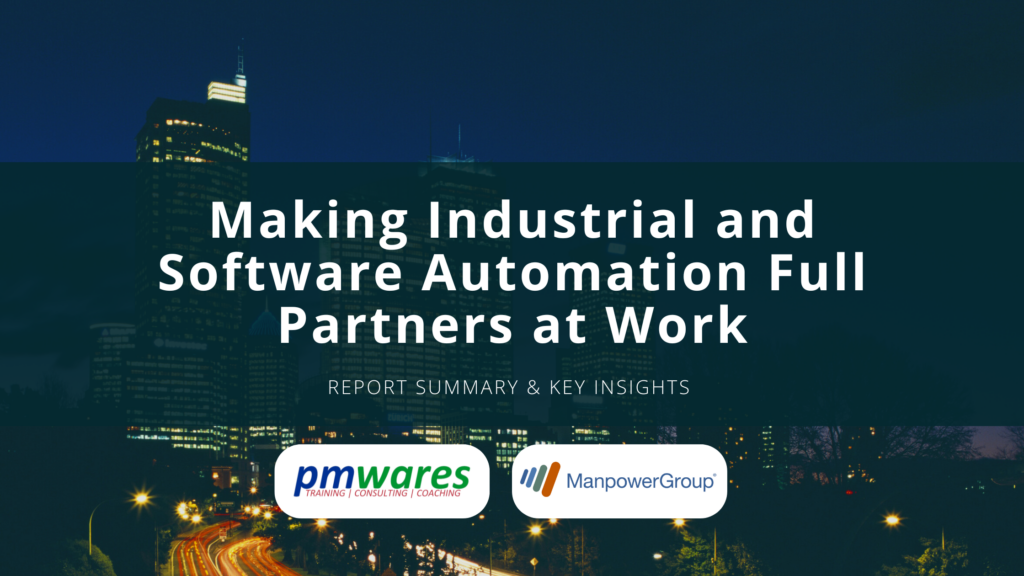Making Industrial and Software Automation Full Partners at Work – Report by Manpower Group India Summary

The report, by ManpowerGroup’s Work Intelligence Lab, explores the current landscape of workforce automation, global investment trends, and provides recommendations for business leaders on effectively integrating human and machine partners. It defines the two major types of workforce automation as industrial automation, which uses physical robots for manual labor in production settings and software automation, which enhances productivity by delegating simpler digital tasks to smart machines. The central theme is that automation will significantly impact human work but will not replace it. Its effectiveness depends on how it is designed, incorporated and overseen. It highlights the importance of human-machine collaboration, strategic planning and upskilling to create a competitive advantage in an increasingly automated world.
Key Insights
- Investment Growth: 61% of global companies planned to increase their investment in task and process automation post mid-2025.
- Impact of Global Factors: The figure is higher for organizations highly impacted by workforce aging (71%) and uncertainty around international trade (68%).
- Geographic Investment: South and Central America lead in increasing automation investment at 68%, followed by North America with 63%, Asia Pacific with 62% and Europe with 58%.
- Industry-Specific Investment: High-tech sectors are most ambitious: Communications Services (71%), Information Technology (70%) and Financials & Real Estate (67%).
- Company Size Investment: Large enterprise businesses (5,000+ employees) are the most bullish (68%), while small businesses (less than 50 employees) are more conservative (58%) in increasing investment.
- Worker Concerns: Employees are more concerned about economic instability (34%) than being replaced by AI or other automation technology (19%).
- Layoffs/Hiring Outlook: Most employers expected to keep their headcount flat or hire in Q3 2025 and only 16% anticipated decreases.
- Autonomous Agent Development: 26% of global companies are heavily investing in autonomous agent development, and another 42% are actively exploring it.
- C-Suite Plans: 92% of C-suite executives planned to digitize workflows and leverage some degree of AI-powered automation by 2026.
- Automation’s Impact on Roles: Automation is still mostly aiding in human role redesign and augmentation versus rendering humans unnecessary.
- Replacing Contingent Workers: Only 14% of large staffing buyers have replaced temporary workers with automation.
- Automated Management: Nearly 40% of U.S. employees reported some form of automated management at their workplace in 2024.
- Most-Impacted Job Functions by 2030: Respondents anticipated the most change in IT & Data (76%), followed by Manufacturing & Production (71%), Sales & Marketing (71%), and Operations & Logistics (71%).
- Least-Impacted Job Functions by 2030: The least likely to be affected were ESG Risk, Advisory & Governance with 63%.
- Agentic AI: Intelligent automation tools such as agentic AI are likely to replace generative AI as the next workforce MVP.
- Amazon Robotics: As of 2025, Amazon had deployed over 750,000 physical robots across its operations.
- Amazon Productivity Forecast: The further incorporation of AI into industrial automation is likely to result in a 25% productivity improvement at Amazon’s next-generation fulfillment centers.
- Carnegie Mellon Experiment: A simulated software company run entirely by AI-based agents failed, proving automation isn’t the answer to everything and that AI agents can misinterpret feedback and lack common sense.
- Gen Z Fear: Members of Generation Z fear being replaced by technology more than members of older generations.
Conclusion
The successful integration of industrial and software automation demands a strategic approach focused on human oversight, system design and continuous workforce development. Business leaders are advised to design human-friendly systems, connect systems from end-to-end, create an infrastructure for human/machine team assembly and supervise AI systems. For this, they must upskill and empower human colleagues and measure success beyond raw productivity by tracking metrics like error reduction and employee satisfaction during the transition. While automation investment is rapidly increasing globally and across sectors, particularly in high-tech and large enterprises, the future of work depends on augmenting human capabilities, not outright replacement, requiring investment in skilled technical talent and well-defined human-machine partnerships. You can read the full report here.